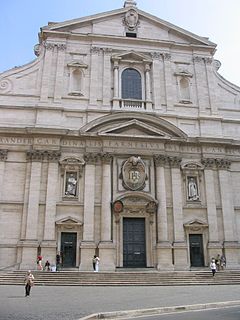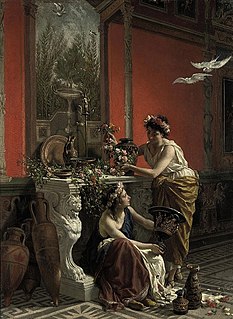
Colonna is the 3rd rione of Rome, identified by the initials R. III and located at the city's historic center in Municipio I. It takes its name from the Column of Marcus Aurelius in the Piazza Colonna, the rione's main piazza.

Borgo is the 14th rione of Rome, Italy. It is identified by the initials R. XIV and is included within Municipio I.

The Basilica of St. Augustine in Campo Marzio, commonly known as Basilica of St. Augustine and locally as Sant'Agostino, is a Roman Catholic titular minor basilica dedicated to Saint Augustine of Hippo in Rome, Italy. It is the mother church of the Order of Saint Augustine and it is located near the Piazza Navona in the rione Sant'Eustachio.

Giacomo della Porta (1532–1602) was an Italian architect and sculptor, who worked on many important buildings in Rome, including St. Peter's Basilica. He was born at Porlezza, Lombardy and died in Rome.

There are more than 900 churches in Rome. Most, but not all, of these are Catholic.

Cosimo Fanzago was an Italian architect and sculptor, generally considered the greatest such artist of the Baroque period in Naples, Italy.

Giuseppe Valadier was an Italian architect and designer, urban planner and archaeologist and a chief exponent of Neoclassicism in Italy.

Stefano Pozzi was an Italian painter, designer, draughtsman and decorator whose career was spent largely in Rome.

The Archdiocese of Bologna is a Latin Church ecclesiastical territory or archdiocese of the Catholic Church in Northern Italy. The cathedra is in the cathedral church of San Pietro, Bologna. The current archbishop is Cardinal Matteo Zuppi, who was installed in 2015.

Via dei Tribunali is a street in the old historic center of Naples, Italy.

The Palazzo Colonna is a palatial block of buildings in central Rome, Italy, at the base of the Quirinal Hill, and adjacent to the church of Santi Apostoli. It is built in part over the ruins of an old Roman serapeum, and it has belonged to the prominent Colonna family for over twenty generations.

Giuseppe Bartolomeo Chiari, also known simply as Giuseppe Chiari, was an Italian painter of the late-Baroque period, active mostly in Rome.

Filippo Raguzzini was an Italian architect best known for a range of buildings constructed during the reign of Benedict XIII.

Cesare Mariani was an Italian painter and architect of the late-19th century, active in Rome and Ascoli Piceno.

Mattia de Rossi was an Italian architect of the Baroque period, active mainly in Rome and surrounding towns.
Giuseppe Sardi was an Italian architect active in Rome. He was born at Sant'Angelo in Vado, Marche which was then part of the Papal States. Known primarily for his church of Santa Maria del Rosario in Marino outside Rome, his name has been linked with the design of the façade of the church of Santa Maria Maddalena in Rome although his involvement with this and with some other building projects remains uncertain. He is not to be confused with the Swiss Italian architect, Giuseppe Sardi (1624–1699), who was active in Venice.

Carlo Francesco Bizzaccheri was an Italian architect. He worked in a Baroque and early Rococo style.

Giambattista Orsini was an Italian Roman Catholic cardinal. He served as papal legate to the Marches of Ancona.
Arcangelo Guglielmelli was an Italian architect and painter, active in his native Naples, Italy, in a late-Baroque style. He was involved in the building and reconstruction of churches, many of which had been damaged by the earthquakes of 1688 and 1694.

















